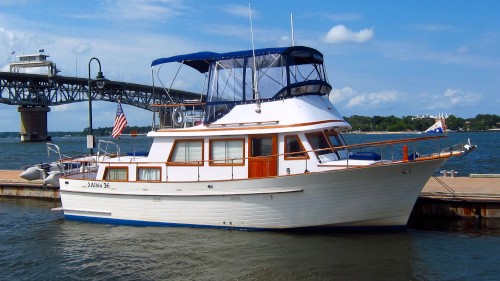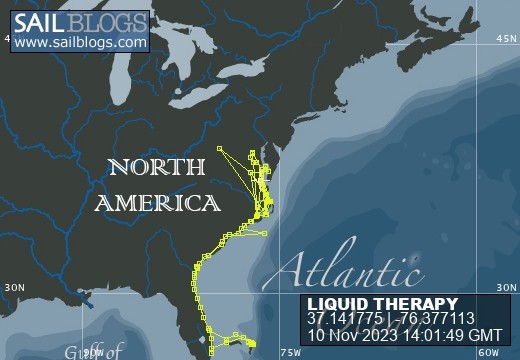MORE DC WIRING

Tuesday & Wednesday the 2nd & 3rd days of November, 2010
More wiring notes. I just could not wait any longer and ordered two blue sea systems busbars to replace the negative DC connections in my main DC panel and the Flybridge terminal block. I have been amazed that my DC stuff wired through the DC breakers has continued to operate with the green stuff growing out of the main negative lead going to the house battery. The house battery is at the aft end and I guess it's a 25' run from the battery to the wiring panel. I replaced the negative cable terminal at the battery a while back. But the other end of this #6 (I'm guessing the gauge as the black cable has no markings) black cable had a very small ring connector that connected to a terminal black in the electric panel. I'm sorry I didn't take a before picture. But the terminal block is one of those types that has looping connecters that connect screw to screw to cascade the -12 VDC. This is the connection point for ALL attached devices (lights , pumps etc) for the negative non-switched side of the house battery. Of course some screws had triple wires under the screws as there were not enough screws for all the -12 V connections. I installed a 20 screw buss bar made by Blue Sea Systems along side the existing screw terminal. I transitioned each wire to the new buss and straightened out crossed over wires and neatened the jumbled mess with velcro wire ties. I then cut off the corroded green terminal connector of the negative battery cable. I connected a very nice cable lug to the negative supply cable and connected it to the main terminal of the new buss. I actually think the 12v lights are brighter!
Now on up to the flybridge terminal strip. I did take before and after pictures of the wiring under the fly bridge. As with all older boats, many radios, lorans, depth finders have been installed over the years. This leads to a rats nest as most people do not disconnect the old wiring of the device they are replacing. Well, if it's dead I remove the wire for sanity. I leave what wiring is relevant. Under the flybridge they had one screw terminal block for everything positive or negative 12v hooked up there on the flybridge. There were 12 screw terminals for connections to connect:
Temperature gauge
Oil pressure gauge
Oil pressure alarm
Tachometer
Running lights port & starboard
Dash lights
Search light
VHF
GPS
Depth finder
Radar
Compass light
25 connections if Im remembering correctly !!!!
The start, stop and horn were in a separate wiring harness. So, they were not involved with the screw terminal block. To make things much worse, the existing screw terminal block was located directly behind the 3 hydraulic steering lines. This was not only awkward for viewing and using a screwdriver with the screw terminals, but the hydraulic lines are at ground -12VDC. So, you had to cut off the battery supply or risk causing a spark / fuse blowing episode when the screw driver came in contact with a +12VDC screw and the shaft hit one of the hydraulic lines. And, no I didn't discover that fact with a spark!
I replaced the existing single terminal block with two new blocks. I put all the -12VDC connections on a Blue Sea Busbar. (Blue Sea Systems www.bluesea.com makes top notch marine electrical devices. ) I mounted the buss bar well to the port side of the hydraulic lines. I intended to reuse the existing terminal block for all other connections. I discovered cracks in the block, and off to my favorite Hurds Hardware in Deltaville. They can get anything marine and compete successfully with West Marine. They had a 10 screw terminal in stock and that's I mounted on the starboard side of the hydraulic lines to handle all the +12VDC connections. I labeled all the source and load wires and neatened the wires up with various cable management. Take a look at the BEFORE picture with 3 connectors under some screws; and then the AFTER picture with two separate terminal blocks.
Next thing will be better +12VDC to the 12V breakers.
More wiring notes. I just could not wait any longer and ordered two blue sea systems busbars to replace the negative DC connections in my main DC panel and the Flybridge terminal block. I have been amazed that my DC stuff wired through the DC breakers has continued to operate with the green stuff growing out of the main negative lead going to the house battery. The house battery is at the aft end and I guess it's a 25' run from the battery to the wiring panel. I replaced the negative cable terminal at the battery a while back. But the other end of this #6 (I'm guessing the gauge as the black cable has no markings) black cable had a very small ring connector that connected to a terminal black in the electric panel. I'm sorry I didn't take a before picture. But the terminal block is one of those types that has looping connecters that connect screw to screw to cascade the -12 VDC. This is the connection point for ALL attached devices (lights , pumps etc) for the negative non-switched side of the house battery. Of course some screws had triple wires under the screws as there were not enough screws for all the -12 V connections. I installed a 20 screw buss bar made by Blue Sea Systems along side the existing screw terminal. I transitioned each wire to the new buss and straightened out crossed over wires and neatened the jumbled mess with velcro wire ties. I then cut off the corroded green terminal connector of the negative battery cable. I connected a very nice cable lug to the negative supply cable and connected it to the main terminal of the new buss. I actually think the 12v lights are brighter!
Now on up to the flybridge terminal strip. I did take before and after pictures of the wiring under the fly bridge. As with all older boats, many radios, lorans, depth finders have been installed over the years. This leads to a rats nest as most people do not disconnect the old wiring of the device they are replacing. Well, if it's dead I remove the wire for sanity. I leave what wiring is relevant. Under the flybridge they had one screw terminal block for everything positive or negative 12v hooked up there on the flybridge. There were 12 screw terminals for connections to connect:
Temperature gauge
Oil pressure gauge
Oil pressure alarm
Tachometer
Running lights port & starboard
Dash lights
Search light
VHF
GPS
Depth finder
Radar
Compass light
25 connections if Im remembering correctly !!!!
The start, stop and horn were in a separate wiring harness. So, they were not involved with the screw terminal block. To make things much worse, the existing screw terminal block was located directly behind the 3 hydraulic steering lines. This was not only awkward for viewing and using a screwdriver with the screw terminals, but the hydraulic lines are at ground -12VDC. So, you had to cut off the battery supply or risk causing a spark / fuse blowing episode when the screw driver came in contact with a +12VDC screw and the shaft hit one of the hydraulic lines. And, no I didn't discover that fact with a spark!
I replaced the existing single terminal block with two new blocks. I put all the -12VDC connections on a Blue Sea Busbar. (Blue Sea Systems www.bluesea.com makes top notch marine electrical devices. ) I mounted the buss bar well to the port side of the hydraulic lines. I intended to reuse the existing terminal block for all other connections. I discovered cracks in the block, and off to my favorite Hurds Hardware in Deltaville. They can get anything marine and compete successfully with West Marine. They had a 10 screw terminal in stock and that's I mounted on the starboard side of the hydraulic lines to handle all the +12VDC connections. I labeled all the source and load wires and neatened the wires up with various cable management. Take a look at the BEFORE picture with 3 connectors under some screws; and then the AFTER picture with two separate terminal blocks.
Next thing will be better +12VDC to the 12V breakers.



Comments